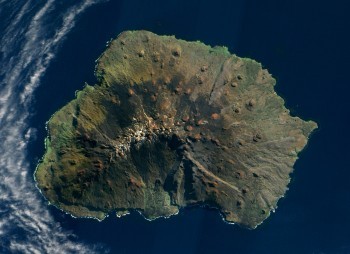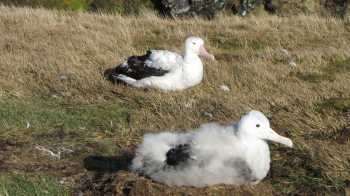Each year in April South Africa’s Antarctic research and supply ship, for the first time this year the one-year-old S.A. Agulhas II, travels to the sub-Antarctic Prince Edward Islands to relieve the year team that runs the weather base and conducts field research on Marion Island.
NASA Earth Observer 1 ALI satellite photograph of Marion Island
on an unusually near-cloudless day
Among the several ongoing research projects conducted on the island are two that work closely together to study the island’s seabirds, including its suite of eight ACAP-listed albatrosses and petrels.
In the last year field assistants from the Branch: Oceans & Coasts of the South African Department of Environmental Affairs have undertaken whole-island counts of incubating Wandering Diomedea exulans, Grey-headed Thalassarche chrysostoma, Sooty Phoebetria fusca and Light-mantled Sooty P. palpebrata Albatrosses, as well as of Northern Macronectes halli and Southern M. giganteus Giant Petrels. For most of these species similar counts are conducted shortly before fledging, so that breeding production and an estimate of breeding success become known. Time series for these counts now go back for more than two decades, and once more will be undertaken over the 2013/14 breeding season by the recently arrived three-person field team.
More intensive studies on the Wandering and Grey-headed Albatrosses and the two sooty Albatrosses and Northern Giant Petrels are undertaken each year by two-person field teams from the DST/NRF Centre of Excellence at the Percy FitzPatrick Institute of African Ornithology, University of Cape Town, with colour-banded birds on marked nests in study colonies for each species being followed through the season.
Wandering Albatross parent and chick on Marion Island
Photograph by John Cooper
In addition, the two 2013/14 field assistants, Kim Stevens and Stefan Schoombie from the FitzPatrick Institute will undertake at-sea tracking studies of Grey-headed Albatrosses and sooty albatrosses towards their MSc degrees.
The ACAP Information Officer is also on the relief, making his annual pilgrimage to the island. This year he is mainly acting as a field and safety guide on overnight hikes for “first-timers” to the island from the British Antarctic Survey, the DST/NRF Centre of Excellence for Invasion Biology, Stellenbosch University and the Social History Department, Iziko Museums of South Africa. Busy, busy, but time will still be found to admire the albatrosses and bag a few more peaks.
John Cooper, ACAP Information Officer, 16 April 2013

 English
English  Français
Français  Español
Español 
